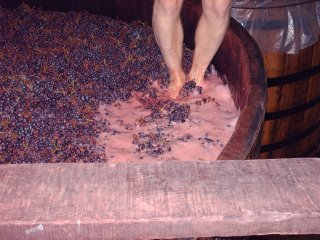Over the last two (?) weeks Ive watched a story grow much like one of those snowballs you see on cartoons that gets lobbed at the top of a mountain. Slowly it rolls downwards getting bigger and bigger and bigger until it wipes out a town. Heres a run down of what happened.
In February of this year Cam Wheeler of Appelation Australia posted a piece on his blog about the wines of Graeme Miller Wines based in the Yarra Valley (http://www.camwheeler.com/wine/2006/exhibition-of-victorian-winemakers-2006-graeme-miller-wines/). Now the tone of the piece is very friendly and positive, but one of the wines is noted to be exceptionally faulty, and hence rates a score of 50/100. For those unfamiliar with the Parker scoring system*, fifty is about as low as you can get. Basically you get 50 points just for being a liquid in a bottle. Cam noted that he hoped this wasnt representative of the wines, rather than a fault in the bottle. However the winemaker at the show stood behind the bottle and didnt offer a further sample to check. So Cam confered with others whom had attended the tasting and their notes concured. So he went ahead and posted his notes online.
Cut forward three months and he gets an email purporting to be from Graeme Miller threatening him with legal action unless he removed his post from the internet. Not very wise council there then. Their continued attempts to bully and threaten Cam have meant that the story has now grown significantly bigger, much like that snowball, and has crossed the series of tubes we know and love as the Internet. I think it was William Randall Hearst that said "all publicity is good publicity" , but this is bad marketing for the winery. And if they continue this route they seem to have chosen they probably wont recover from it, because people wont focus on their wines rather than their response to this situation. I wish Cam all the success in this battle, and support his decision to publish the review. All to often we only see glowing positive reviews, and its equally important to read not so positive reviews, as long as those reviews are objective and truthful.
The whole scenario got me thinking about the dozens of wines a month that we taste here, but that never get a listing. I can honestly say that it is a long time since I have tasted a truly horrible wine. I would like to think that it is because there are fewer and fewer really bad wines on the market, but to be truthfull, I suspect that our suppliers filter some of the poorer wines out, and only supply samples of higher quality wines. When we do our tasting for the brasserie we will often taste about thirty wines at a time. Usually we will arrange them into flights, so that we are tasting all the sauvignons together, all the chards together etc etc. Often this means that we will try maybe five or six of each variety and the two that stick out will then go head to head on cost/presentation and availability. It has happened on a few occasions that the wine we have ultimately chosen to be listed perhaps was the second or even third best wine, but due to pricing considerations or supplier politics, we have rejected the better wine. Its not a comfortable decision, but sometimes it needs to be made.
So I guess Im lucky that I havent really come across a really bad wine, and I'll tell you what. I hope to goodness it stays that way.
(*The 100 point scale was introduced by Robert Parker Jnr the american lawyer turned wine critic in 1978 when he introduced his newsletter "The Wine Advocate". It was consequently adopted by the Wine Spectator magazine and has since become the de facto standard for many wine reviews. For a fuller explaination of the wine rating systems see Stephen De Longs post on the subject at http://www.delongwine.com/news/2006/05/09/how-we-rate-wines-and-other-things/)
Subscribe to:
Post Comments (Atom)





No comments:
Post a Comment